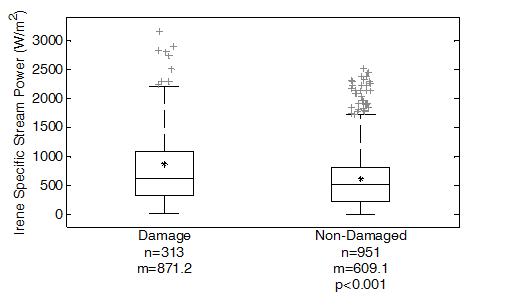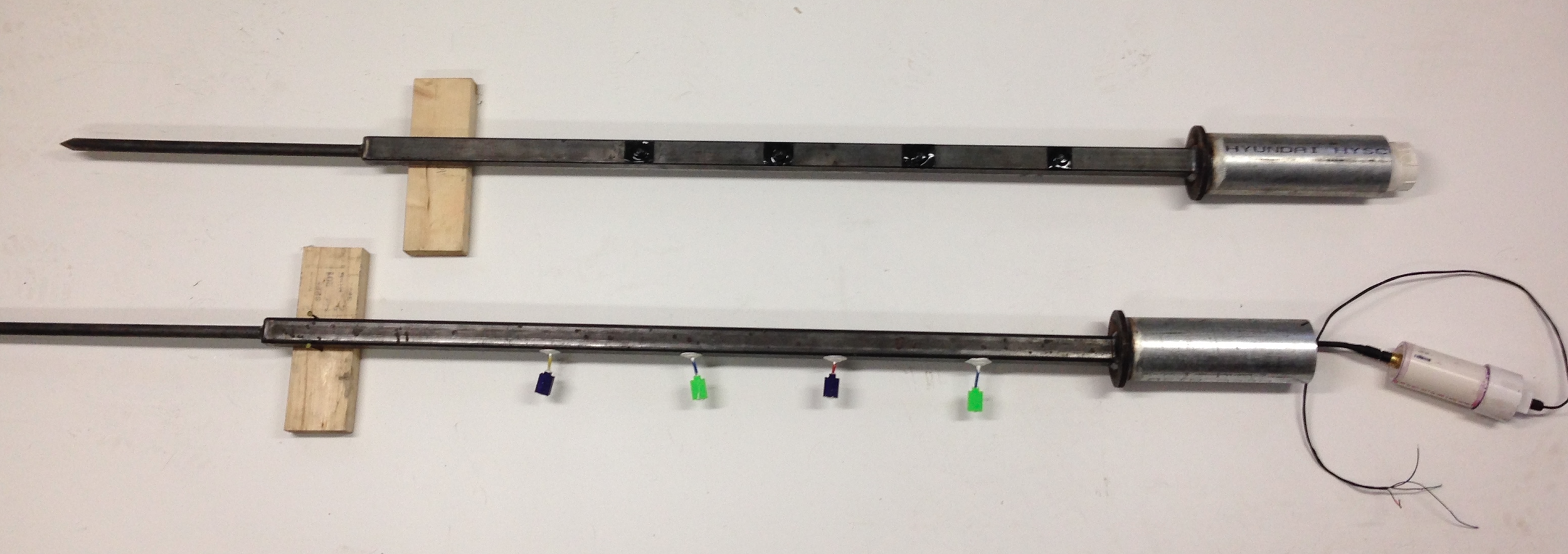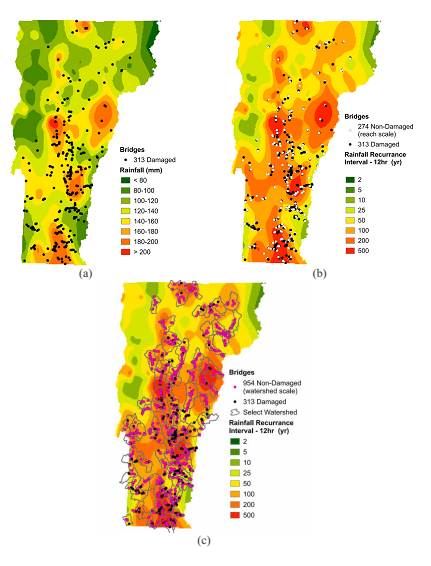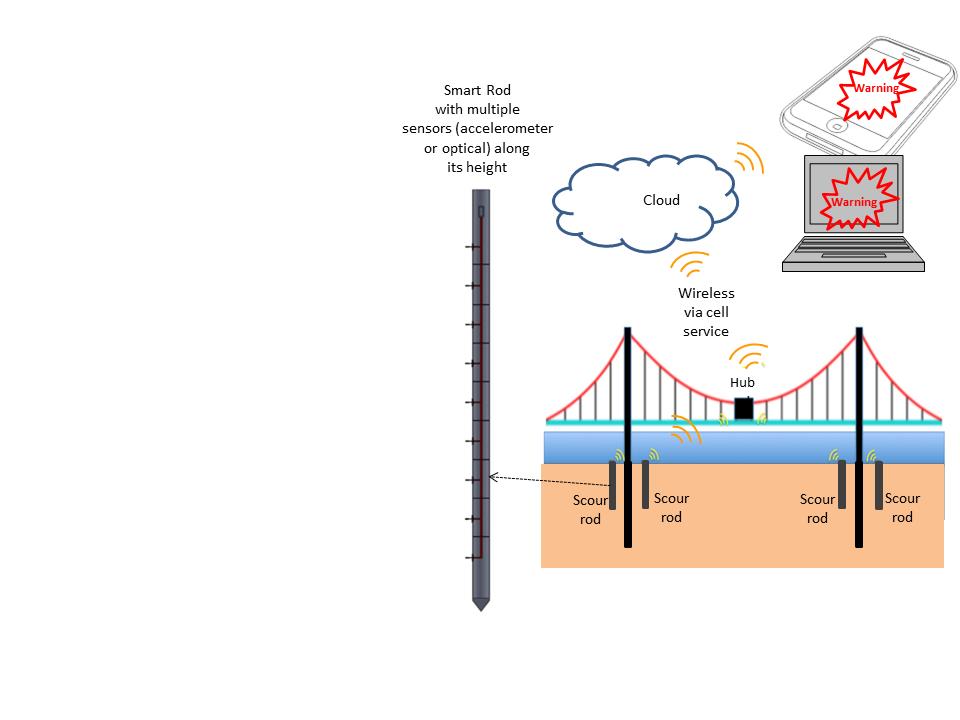
Given the devastating consequences of climate change and natural and human-induced hazards, it is essential to develop adaptation and mitigation strategies to protect human lives, civil infrastructure and the environment. This requires research on different aspects of climate change, natural hazards, and development of effective policies, plans and strategies to minimize the unavoidable impacts of climate change and natural and human-induced hazards.
Streambank erosion and sediment loading in rivers within the context of climate change

Collaborators: Mandar Dewoolkar, Donna Rizzo, Arne Bomblies (Civil and Environmental Engineering), Jeff Frolik (Electrical Engineering), Beverley Wemple (Geography), Paul Bierman (Geology), Jarlath P. M. O’Neil-Dunne (Rubenstein School of Environment and Natural Resources)
Students Involved: Jaron Borg, Kristen Underwood, Scott Hamshaw, and Jody Stryker
Description: Streambank erosion is recognized as one of the most important nonpoint sources of sediment and phosphorus entering streams, rivers, and lakes, and thus one of the largest contributors to the impairment of surface water quality and aquatic habitat. We combine many concepts of soil mechanics, geology, hydrology, and sensor technology to gain fundamental understanding of the mechanics of riverbank instability and the source of sediments in streams contributing to increasing phosphorus levels in Lake Champlain. Using in-situ and laboratory testing of streambank soils, determining soil erodibility, continuous remote monitoring of embedded instrumentation, and transient flow and slope stability modeling, we are learning what makes some banks stable and other banks fail over both time and changing river/groundwater conditions. Additionally, a sediment fingerprinting study is underway. Recent additions to this research have included quantification of streambank erosion and deposition using terrestrial LiDAR and unmanned aerial systems (UAS). This research is currently funded through VT EPSCoR's Research on Adaptation to Climate Change grantand Vermont Water Resources & Lake Studies Center
Publications:
Borg, J., Dewoolkar, M. M., and Bierman, P. (2014), “Assessment of streambank stability – a case study”, Geo-Congress 2014 Technical Papers: pp. 1007-1016, doi: 10.1061/9780784413272.098
Hamshaw, S. D., Rizzo, D. M., Underwood, K. L., Wemple, B. C., & Dewoolkar, M. (2014, March 26). Suspended Sediment Prediction Using Artificial Neural Networks and Local Hydrometeorological Data. Poster presented at the 2014 NEAEB Conference, Burlington, VT.
Hamshaw, S. D., Rizzo, D. M., Underwood, K. L., Wemple, B. C., & Dewoolkar, M. (2014b, March 28). High Frequency Turbidity Monitoring to Quantify Sediment Loading in the Mad River. Presented at the 2014 NEAEB Conference, Burlington, VT.
Rizzo, D.M., S.D. Hamshaw, H. Anderson, K.L. Underwood and M.M. Dewoolkar (2013), “Estimates of Sediment Loading from Streambank Erosion Using Terrestrial LIDAR sediment in rivers using artificial neural networks: Implications for development of sediment budgets”, EOS Transactions, American Geophysical Union, Abstract H13D-1353, Fall Meeting, San Francisco, CA, December.
Research Project: Earthquake Induced Liquefaction
PI: Mandar Dewoolkar
Graduate Students Involved: Lalita Oka, Jay Hargy (UNH)
Undergraduate Students Involved: Ian Anderson, Kyle Bowley, Stefan Desis, Michael Parks and Alain Therrien
Description: Earthquakes pose one of the grave threats to the safety of infrastructure and lives. Liquefaction is a phenomenon normally associated with earthquakes where saturated soils lose their strength and stiffness due to dynamic loading and behave like liquid. This research has explored some aspects of soil liquefaction:(1) the effects of presence of large structures on field penetration resistance and shear wave velocity measurements and other factors considered in the liquefaction potential evaluation; (2) the effects of non-plastic fines on shear wave velocity and liquefaction resistance of sands; and (3) assessment of post-earthquake residual strength of liquefiable sands. Part of this research has been funded by the National Science Foundation.
Publications:
Dewoolkar, M. M., Hargy, J., Anderson, I., de Alba, P., and Olson, S. M. (2016), "Residual and postliquefaction strength of a liquefiable sand", Journal of Geotechnical and Geoenvironmental Engineering, 142(2), http://ascelibrary.org/doi/abs/10.1061/(ASCE)GT.1943-5606.0001374.
Dewoolkar, M. M., Hargy, J., Anderson, I., de Alba, P., and Olson, S. M. (2016), "Residual and postliquefaction strength of a liquefiable sand", Journal of Geotechnical and Geoenvironmental Engineering, 142(2), http://ascelibrary.org/doi/abs/10.1061/(ASCE)GT.1943-5606.0001374.
Dewoolkar, M. M., Hargy, J., Anderson, I., de Alba, P., and Olson, S. M. (2016), "Residual and postliquefaction strength of a liquefiable sand", Journal of Geotechnical and Geoenvironmental Engineering, 142(2), http://ascelibrary.org/doi/abs/10.1061/(ASCE)GT.1943-5606.0001374.
Anderson, I., Hargy, J., de Alba, P., and Dewoolkar, M. M. (2012), "Measurement of residual strength of liquefied soil in centrifuge models", GeoCongress 2012 Conference, Oakland, CA.
Oka, L. G., and Dewoolkar, M. M. (2007), “Effect of existing dams on liquefaction potential analysis of foundation soils”, GeoDenver 2007 New Peaks in Geotechnics, Dynamic Response and Soil Properties, ASCE Geotechnical Special Publication No. 160, Dewoolkar and Koester (eds).
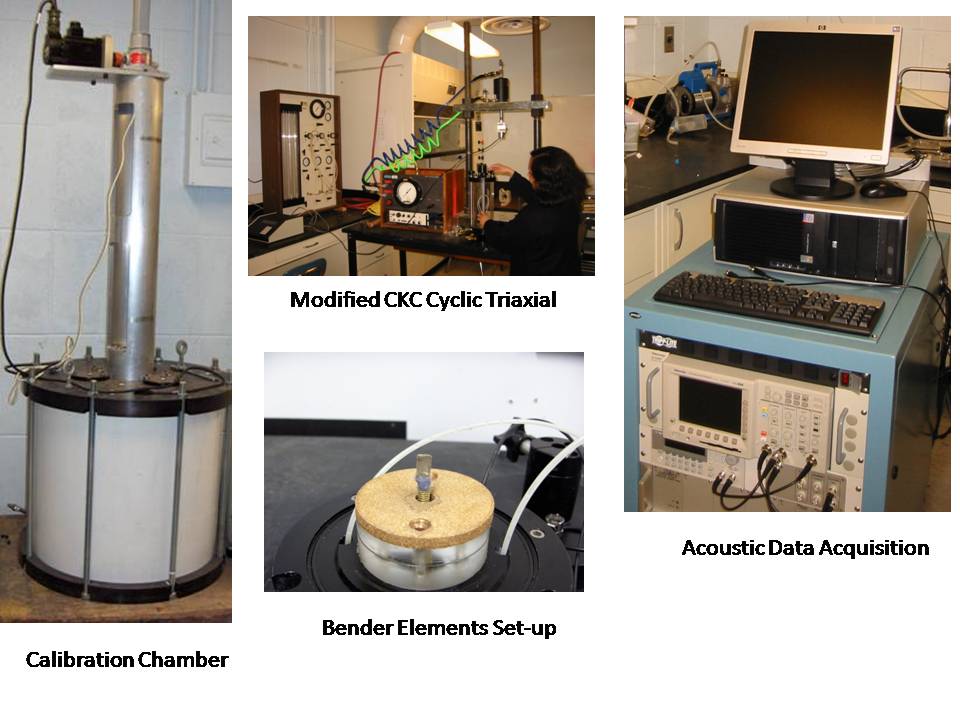
Research Project: Contaminant Transport in Building Materials
PIs: Mandar Dewoolkar, Donna Rizzo and Nancy Hayden
Graduate Students Involved: Cabot Savidge and David Grover
Undergraduate Students Involved: Odanis Rosario and Laura Townsend
Description: This study supported an overarching goal of understanding fate and transport of chemical agents in porous materials used in heritage and essential facilities, so appropriate decontamination strategies could be developed. The study is also relevant to building contamination from fires and environmental pollution, which continues to be a serious and expensive problem rendering buildings unusable for long periods of time. This research has been funded by the Los Alamos National Laboratory, Defense Threat Reduction Agency and Defense Science and Technology Laboratory (U.K.).
Publications:
Grover, D., Savidge, C. R., Townsend, L., Rosario, O., Hu, L.-B., Rizzo, D. M., and Dewoolkar, M. M. (2016), "Surface permeability of natural and engineered porous building materials", Construction and Building Materials, 112, 1088-1100, http://www.sciencedirect.com/science/article/pii/S0950061816302525.
Hu, L., Savidge, C., Rizzo, D., Hayden, N. Hagadorn, W., and Dewoolkar, M., "Commonly used porous building materials - geomorphic pore structure and fluid transport", Journal of Materials in Civil Engineering, 25(12), http://ascelibrary.org/doi/abs/10.1061/%28ASCE%29MT.1943-5533.0000706.
Savidge, C. R., Hu., L. B., Hayden, N. J., Rizzo, D., and Dewoolkar, M. M. (2008), "Variability in surface permeability of porous building substrates and their implications on transport of agents", Chemical and Biological Defense Physical Science and Technology Conference, New Orleans, November.
Hu, L. B., Savidge, C. R., Brownell, M., Hayden. N. J., Rizzo, D., and Dewoolkar, M. M. (2008), "Prediction of agent transport in porous building materials", Chemical and Biological Defense Physcial Science and Technology Conference, New Orleans, LA, November.
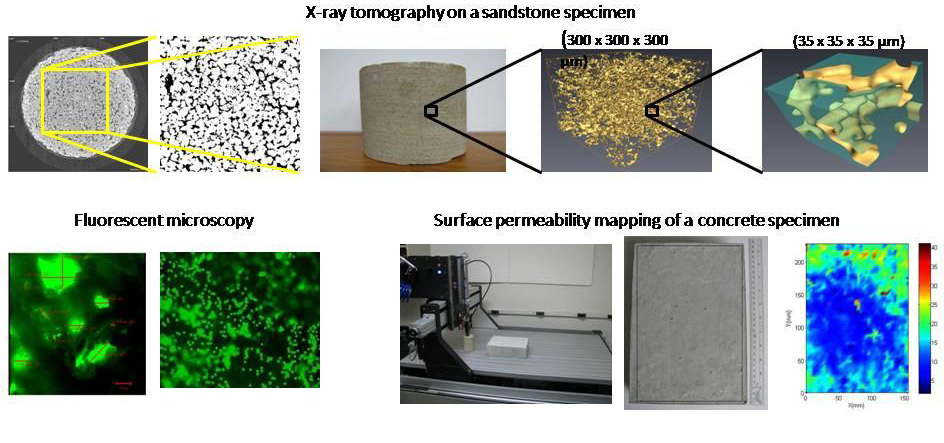
Research Project: Streambank Erosion, Sediment Transport, Impacts on Water Bodies
PIs: Mandar Dewoolkar, Donna Rizzo and Paul Bierman
Graduate Students Involved: Jaron Borg, Kristen Underwood and Scott Hamshaw
Undergraduate Students Involved: None
Description: Streambank erosion is recognized as one of the most important nonpoint sources of sediment and phosphorus entering streams, rivers, and lakes, and thus one of the largest contributors to the impairment of surface water quality and aquatic habitat. We combined many concepts of soil mechanics and geology to gain fundamental understanding of the mechanics of riverbank instability and the source of sediments in streams contributing to increasing phosphorus levels in Lake Champlain. Using in-situ and laboratory testing of streambank soils, determining soil erodibility, continuous remote monitoring of embedded instrumentation, and transient flow and slope stability modeling, we are learning what makes some banks stable and other banks fail over both time and changing river and groundwater conditions. Additionally, a sediment fingerprinting study is being conducted to understand where the sediments come from. We have also employed terrestrial LiDAR and Unmanned Aerial Systems to quantify streambank movements at site-specific and river corridor scales. Large quantity of data are also being collected on total suspended sediment, turbidity, and other indicators of pollutants. The funding sources have included Vermont Water Resources & Lake Studies Center, VT NSF EPSCoR's Research on Adaptation to Climate Change grant and Basin Resilience to Extreme Events grant.
Publications:
Hamshaw, S. D., Bryce, T., Rizzo, D. M., O'Neil-Dunne, J., Frolik, J., and Dewoolkar, M. M. (2017), "Quantifying streambank movement and topography using unmanned aircraft system photogrammetry with comparsion to terrestrial laser scanning," River Research and Applications, DOI: 10.1002/rra.3183.
Hamshaw, S. D., Bryce, T., O’Neil Dunne, J., Rizzo, D. M., Frolik, J., Engel, T., and Dewoolkar, M. M., “Quantifying streambank erosion using unmanned aerial systems at the site-specific and river network scales,” GeoCongress 2017.
Borg, J., Dewoolkar, M. M., and Bierman, P. (2014), "Assessment of streambank stability - a case study," Geo-Congress 2014, pp. 1007-1016.
Underwood, K. L., C. Alves, D. S. Ross, M.M. Dewoolkar and D.M. Rizzo (2016), “Influence of Geomorphic Setting on Distribution of Nutrient Stocks in Lake Champlain basin Floodplains”, The Geological Society of America, Northeast Secion – 51st Annual Meeting, T7. Interaction between the Landscape and Aquatic Biogeochemistry, Abstract# 272354, March 21-23, 2016, Accepted 2015.
Hamshaw, S.D., Underwood, K.L., Rizzo, D.M., O’Neil, J., and Dewoolkar, M. M. (2015), “Quantifying streambank erosion: a comparative study using an unmanned aerial system (UAS) and a terrestrial laser scanner”, EOS Transactions, American Geophysical Union, NH43C-1913, Abstract ID # 85568, Fall Meeting, San Francisco, CA, December.
Hamshaw, S.D., Underwood, K.L., Dewoolkar, M.M. and Rizzo, D.M. (2015), “Sediment Loading and Sources in the Mad River Implication s for Sediment-bound Nutrient Management” IAGLR (International Association for Great Lakes Research), 58th Annual Conference, Burlington VT, May 25-29.
Hamshaw, S. D., Rizzo, D. M., Underwood, K. L., Wemple, B. C., & Dewoolkar, M. (2014). Suspended Sediment Prediction Using Artificial Neural Networks and Local Hydrometeorological Data. Poster presented at the 2014 NEAEB Conference, Burlington, VT.
Hamshaw, S. D., Rizzo, D. M., Underwood, K. L., Wemple, B. C., & Dewoolkar, M. (2014). High Frequency Turbidity Monitoring to Quantify Sediment Loading in the Mad River. Presented at the 2014 NEAEB Conference, Burlington, VT.
Rizzo, D.M., Hamshaw, S.D., Anderson, H., Underwood, K.L., and Dewoolkar, M.M. (2013), “Estimates of Sediment Loading from Streambank Erosion Using Terrestrial LIDAR sediment in rivers using artificial neural networks: Implications for development of sediment budgets”, EOS Transactions, American Geophysical Union, Abstract H13D-1353, Fall Meeting, San Francisco, CA, December.
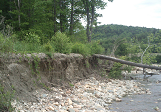
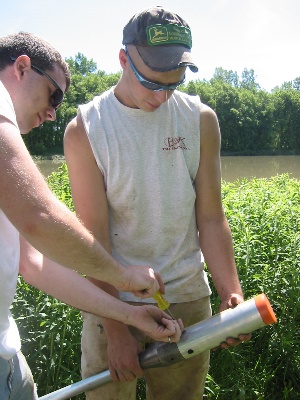
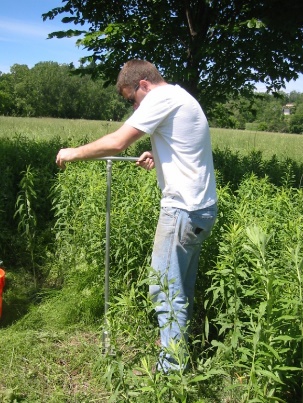

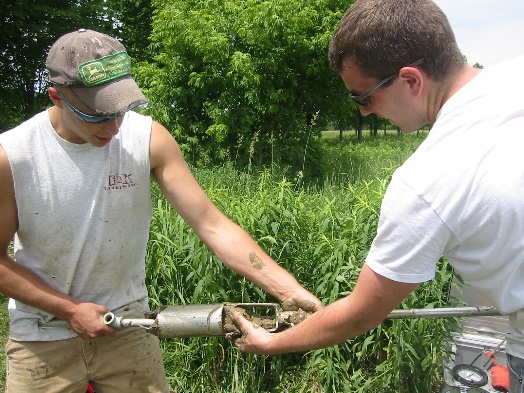

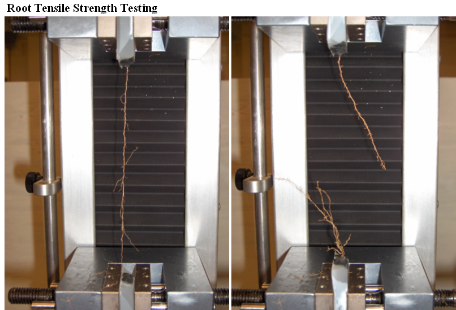

Research Project: Prediction and Mitigation of Scour and Scour Damage to Bridges
PI: Mandar Dewoolkar
Co-PIs: Donna Rizzo, Dryver Huston and Jeff Frolik
Graduate Students Involved: Ian Anderson, Matthew Brand, Lucas Howard
Undergraduate Students Involved: Sebastian Downs, Caleb Fields, Joseph Hasselman, Heath Hescock, Griffin Jones, Connor Lacasse, Elliot Maker, Albin Meli, Cameron Michaud, Trevon Noiva, Brendan Stringer, Adisun Wheelock and Roy Wu.
Description: Over 300 Vermont bridges were damaged in the 2011 Tropical Storm Irene and many experienced significant scour. Successfully mitigating bridge scour in future flooding events depends on our ability to reliably estimate scour potential, design safe and economical foundation elements accounting for scour potential, design effective scour prevention and countermeasures, and design reliable and economically feasible monitoring systems, which served as the motivation for this study. This project sought to leverage data on existing Vermont bridges and case studies of bridge scour damage, and integrate available information from stream geomorphology to aid in prediction of bridge scour vulnerability. Tropical Storm Irene’s impact on Vermont bridges was used as a case study, providing damage information on a wide range of bridges throughout the StateThis research was funded by the Vermont Agency of Transportation and UVM Transportation Research Center.
Publications:
Anderson, I. A., Rizzo, D. M., Huston, D. R., and Dewoolkar, M. M. (2017), “Analysis of bridge and stream conditions of over 300 Vermont bridges damaged in Tropical Storm Irene”, Structure and Infrastructure Engineering, http://dx.doi.org/10.1080/15732479.2017.1285329.
Anderson, I., Rizzo, D. M., Huston, D. R., and Dewoolkar, M. M. (2017), “Stream power application for bridge-damage probability mapping based on empirical evidence from Tropical Storm Irene”, Journal of Bridge Engineering, 22(5), http://ascelibrary.org/doi/10.1061/%28ASCE%29BE.1943-5592.0001022.
Brand, M. W., Dewoolkar, M. M., and Rizzo, D. M. (2017), “Use of sacrificial embankments to minimize bridge damage from scour during extreme flow events,” Natural Hazards, https://link.springer.com/article/10.1007/s11069-017-2829-z.
Howard, L. J., Anderson, I. A., Underwood, K., Dewoolkar, M. M., Deschaine, L. M., and Rizzo, D. M. (2016), "Heuristic assessment of bridge scour sensitivity using differential evolution: case study for linking floodplain encroachment and bridge scour," Environmental Systems Research, 5:20, DOI 10.1186/s40068-016-0071-4.
Anderson, I., Rizzo, D., Huston, D. and Dewoolkar, M. M. (2015), “System-wide assessment of vulnerability of bridges to scour under extreme flood events”, 7th Int. Conf. on Structural Health Monitoring of Intelligent Infrastructure, Torino, Italy, July.
Anderson, I. A., Dewoolkar, M. M., Rizzo, D. M., and Huston, D. R. (2014), “Vermont bridge scour rating analysis: looking toward utilizing geomorphic stream data”, Geo-Congress 2014 Technical Papers: Geo-Characterization and Modeling for Sustainability: pp. 2665-2674, (doi: 10.1061/9780784413272.257).
